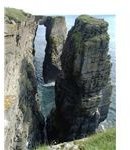

Tides, the generally twice-daily rise and fall of sea levels, are caused by Earth's rotation and the gravitational effects of the Moon and, to a lesser extent, of the Sun. Deep-sea currents, known together as the global conveyor belt, carry cold water from near the poles to every ocean and significantly influence Earth's climate. Surface currents are the water currents that are produced by the atmosphere's currents and its winds blowing over the surface of the water, producing wind waves, setting up through drag slow but stable circulations of water, as in the case of the ocean sustaining deep-sea ocean currents. The surface of water interacts with the atmosphere, exchanging properties such as particles and temperature, as well as currents. The ocean moderates Earth's climate and has important roles in the water, carbon, and nitrogen cycles. The water also contains salts of magnesium, calcium, potassium, and mercury, amongst many other elements, some in minute concentrations. The most abundant solid dissolved in seawater is sodium chloride. The salinity of water bodies varies widely, being lower near the surface and the mouths of large rivers and higher in the depths of the ocean however, the relative proportions of dissolved salts vary little across the oceans. the Mediterranean Sea), or certain large, nearly landlocked bodies of water. Particular seas are either marginal seas, second-order sections of the oceanic sea (e.g. The sea commonly refers to the ocean, the wider body of seawater. For other uses, see Sea (disambiguation) and The Sea (disambiguation).Ĭoastal sea waves at Paracas National Reserve, Ica, PeruĪ sea is a large body of salty water. For natural science aspects, see more at Ocean. This article focuses on human experience, history and culture of the collective seas of Earth.


 0 kommentar(er)
0 kommentar(er)
